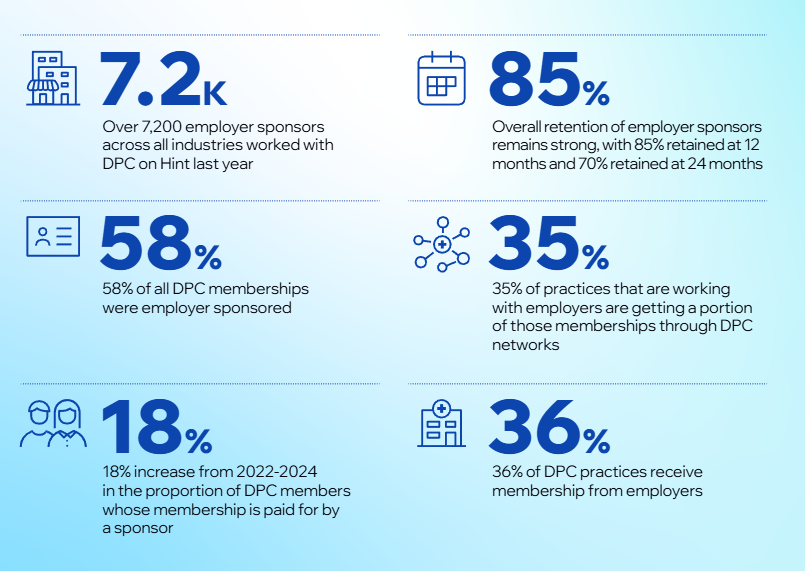Employer-sponsored health insurance costs keep climbing while employees struggle with access and satisfaction. More organizations are turning to employer-sponsored Direct Primary Care (DPC) to reduce costs and improve health outcomes. As of 2025, the data shows an accelerating movement to adopt DPC across industries and geographies.
Our latest Employer Trends in Direct Primary Care 2025 Report compiles data from 2,400+ DPC clinicians, 1.2M+ members, and 7,200 employer sponsors, making it the most comprehensive look at how DPC adoption is evolving nationwide, including the role of DPC networks, results for self-funded employers, and ROI patterns.
Key DPC Employer Trends for 2025
The report reveals that employer adoption of DPC is accelerating:
- 7,200+ employers across industries worked with DPC practices last year.
- 58% of all DPC memberships are employer-sponsored (+18% since 2022).
- Retention remains strong: 85% at 12 months and 70% at 24 months.
- 36% of DPC practices now receive membership through employers.
- 35% of employer-DPC memberships flow through DPC networks, with network-exclusive relationships rising since 2022.
DPC has moved from niche adoption to becoming a mainstream benefit strategy. Employer demand is growing, retention is stable, and DPC panels are tilting toward sponsored members.
Why Employers Are Adopting DPC (What’s Inside)
The full Employer Trends in Direct Primary Care 2025 Report details:
Why employers need a better healthcare strategy
- Escalating premiums and deductibles without commensurate outcomes.
- Access issues: long waits, rushed visits, fragmented care.
- Primary-care workforce strain: burnout and unfilled residencies.
Why employers are leaning into DPC
- Regulatory changes (such as new HSA compatibility rules beginning in 2026) have made DPC even more attractive.
- Lower avoidable utilization (fewer ER visits, reduced hospitalizations) and better chronic care management.
- Higher employee satisfaction and stronger retention.
Trends in employer-sponsored DPC
- 1,000% growth in employer sponsors since 2017.
- Increased adoption spans industrial, public, consumer, and professional sectors.
- Strong adoption by small businesses, with a growing interest from larger employers.
- DPC networks are increasingly connecting multi-location employers to local practices.
Why Employers Should Read This Report
Employers evaluating healthcare benefits need to understand the real-world outcomes of adopting DPC. This report provides:
- Benchmark adoption across industries and employer sizes, with clear growth signals since 2022.
- Evidence of ROI via reduced avoidable utilization, improved chronic disease control, employee health improvements, and retention benefits.
- Forward-looking insights into how DPC networks and regulatory changes will expand adoption in the years ahead
With healthcare costs expected to rise another 7% in 2025, the timing could not be more urgent. Direct Primary Care offers a sustainable path forward that improves access, strengthens the employer brand, and lowers overall spend.
Download the Report
The Employer Trends in Direct Primary Care 2025 Report is now available. Download your copy to explore the full data and learn how your organization can benefit from adopting DPC.


